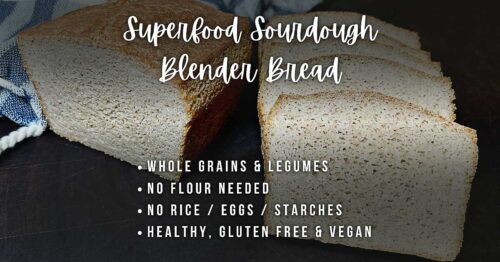Quickly & easily make your own Millet Flour at home in just 3 simple steps! Making millet flour at home is a simple and cost-effective way to enjoy this nutritious, gluten-free ingredient. By grinding your own flour, you can ensure its freshness and quality while avoiding the extra cost of store-bought options. Here’s a step-by-step guide to help you get started.
Millet, is a completely gluten-free ancient grain making it a perfect choice for those with celiac disease or gluten sensitivities. Harness the goodness this ancient grain by making your own millet flour at home!
This recipe is:
WHY YOU'LL LOVE IT!
- Easy to make with step by step video instructions (even 1st time gluten-free bakers can make it).
- DIY Gluten Free Millet Flour FASTER than you can make it to the store to buy some!
- Grind your flour fresh, when you need it!
- Never have to worry about the store being out of stock!
- Fresh flour tastes better & makes better Gluten Free Baking.
Want to make GLUTEN FREE SOURDOUGH?

CONTENTS
1. Ingredients
Millet Grains – organic recommended but not required.
2. Materials List
The essentials you need to make Millet Gluten Free Flour.
3. How to make Gluten Free Sorghum Flour
Here you’ll find easy to follow video instructions to easily make millet flour at home!
7. Frequently Asked Questions (FAQ)
Can’t find the answer to your question? Please feel free to contact me anytime in the comments below or privately on my contact page.
Here I’ll answer questions regarding:
- Why make my own Gluten Free Flour?
- Is Millet naturally gluten free?
- Can I use a coffee grinder to make my own millet flour?

Want more delicious recipes at your fingertips?
Get updates on our latest posts & recipes from TurmericMeCrazy straight to your inbox!
By clicking subscribe you are consenting to receive emails from TurmericMeCrazy. I will only email you monthly with new recipes & updates. No spam I promise!
INGREDIENTS
- Millet Grains – I recommend buying an organic, if possible as this will create the best flour (especially for a sourdough starter).
what is millet?

Millet, is a group of small-seeded grains that belong to the grass family and are grown as staple crops in many parts of the world, especially Asia and Africa. It’s valued for its drought resistance, adaptability to poor soils, and nutritional benefits. Common types of millet include pearl millet, finger millet, and proso millet.
Millet grains can be ground into flour, which is gluten-free and can be used in various gluten free baking recipes.
what does millet flour taste like?
Millet flour has a mild, slightly nutty flavour and a soft texture. Millet’s mild flavour makes it the perfect healthy whole grain flour for sweet & savoury recipes! While millet flour has its own unique flavour, it also has a relatively neutral base, allowing it to blend well with other ingredients in recipes.
Use this lovely gluten free flour to make delicious gluten free bakes! It’s sure to become one of your pantry staples!
what is millet flour used for?
I now use millet flour as one of my healthy staples for gluten free baking and in many of my gluten free flour blends.
Uses of Millet Flour:
- Baking: Ideal for making gluten-free bread, cakes, cookies, and flatbreads.
- Thickening Agent: Can be used to thicken soups and sauces.
- Porridge: Some people mix it with water or milk to create a porridge-like dish.
- Blending: Often mixed with other gluten-free flours like rice or sorghum flour to achieve a balanced texture.
nutritional value of millet flour
Millet is a nutritious ancient grain that contains essential nutrients such as protein, fibre, vitamins and minerals.
Nutritional Benefits of Millet:
- Rich in fiber, which supports digestion.
- High in protein, making it a good plant-based protein source.
- Contains essential nutrients like magnesium, phosphorus, and B vitamins.
- Naturally gluten-free, suitable for gluten-free diets.
MATERIALS LIST - DIY Millet FLour
- Large Bowl
- Fine Mesh Sieve or Strainer
- Microfibre cloth
- High Speed Blender (e.g. Vitamix) or
- Air-tight Container to store flour
how to make gluten free millet flour
PIN THIS diy Millet flour how to guide for later

FREQUENTLY ASKED QUESTIONS
Can’t find the answer to your question? Please feel free to contact me anytime in the comments below or privately on my contact page.
Ever go to the store looking for a specific gluten free flour and they are sold out? I sure have! In fact, I have been on the hunt for certain flours for hours, scouring stores, only to be left disappointed. Yes, we can order online, but what if you want to bake right now? Knowing how to make your own gluten free flours means freedom to bake when you want to!
- Bake when you want to bake!
- Never worry about supply of flours at the store.
- Grind flours fresh when you want to bake!
- Freshly ground flour = better tasting bakes.
- Often save money by buying grains in large bags & grinding yourself!
Yes! Millet is naturally free from gluten, however, where things get tricky is in the farming & the processing facilities. If the millet is processed and packed in a facility that is not dedicated to gluten free, there is always a risk of contamination.
This is why I suggest using organic, certified gluten free millet, but of course the choice is totally yours!
This is a tricky one, I have not tried this and don’t believe that the coffee grinder would be powerful enough to make the flour fine enough for gluten free baking. Fine millet flour will produce lighter, more delicate treats, allowing for more lift & expansion of your doughs!
With that said, if all you have is a coffee grinder, give it a try. Grind a VERY small amount at a time and sift several times. It may just work!
PLEASE RATE & COMMENT
I sure do hope you love this Gluten Free Millet Flour how to guide. If you try it, I’d be ever so grateful if you’d please add a comment & a rating onto the recipe below or at the bottom of the post ♡. This will help Google recognize it and help my website grow.
Thank you once again for your readership & support.
Now let’s make some flour!

Homemade Millet Flour Recipe
Equipment
- 1 High Speed Blender (e.g. Vitamix)
- 1 Large Bowl
- 1 Air Tight Container
Materials
- 500 g Millet Grains Organic & Gluten Free (2 cups)
Instructions
Step 1: Wash Millet Grains
- Pour millet grains onto a microfibre cloth and clean thoroughly by rubbing.500 g Millet Grains
Step 2: Grind Millet Grains to a fine powder
- Use microfibre cloth to pour all dried millet grains into high speed blender.
- Grind on low then increase to high for 2 minutes.
Step 3: Sift Flour
- Using a dry fine mesh strainer, sift flour to filter out any large grains. Discard large grains, or particles.
Step 4: Grind & Sift again (optional)
- Return flour to blender & blend for an additional 1 minute (start on low & increase to high) scraping down the sides of the blender if necessary, until reaches a fine powder consistency.
Store Flour
- Store your DIY millet flour in an airtight container & use within 1 month for best results!
Video
Notes
- See FAQ above to see if you can use your blender or a coffee grinder.
- Fine Millet Flour will produce better baking results. Don't skip the sifting step!
- Try using your freshly milled millet flour to create your own gluten free flour blends. See my guide here to help you discover how!
DELICIOUS RECIPES made with MILLET flour...
Want to make gluten free sourdough...?
Would you like to make a Gluten Free Sourdough Loaf with your fresh Sorghum Flour? You’ll love how easy making this bread becomes with my FREE BAKING TIMELINE & follow-along videos. I sure hope that this helps give you some ease in your gluten free sourdough journey!



























One Response
This is SO easy!